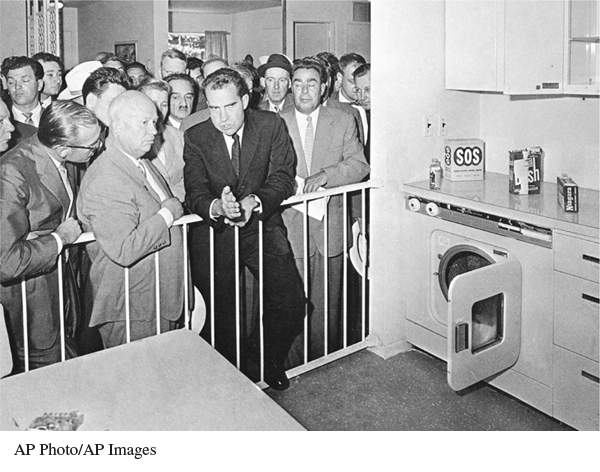A History of Western Society: Printed Page 961
A History of Western Society, Value Edition: Printed Page 923
A History of Western Society, Concise Edition: Printed Page 964
Chapter Chronology
Foreign Policy and Domestic Rebellion
Khrushchev also de-Stalinized Soviet foreign policy. “Peaceful coexistence” with capitalism was possible, he argued, and war was not inevitable. Khrushchev negotiated with Western diplomats, agreeing in 1955, for example, to independence for a neutral Austria after ten long years of Allied occupation. As a result, Cold War tensions relaxed considerably between 1955 and 1957. At the same time, Khrushchev began wooing the new nations of Asia and Africa — even those that were not Communist — with promises of support and economic aid.

The Kitchen Debate Khrushchev and Nixon discuss the merits of the American way during the famous kitchen debate. Leonid Brezhnev, the future leader of the Soviet Union (from 1964 to 1982), stands on the far right, just behind Nixon.
(AP Photo/AP Images)
Page 962
In the East Bloc states, Communist leaders responded in complex ways to de-Stalinization. In East Germany the regime stubbornly resisted reform, but in Poland and Hungary de-Stalinization stimulated rebelliousness. Poland took the lead in 1956, when extensive popular demonstrations brought a new government to power. The new First Secretary of the Polish Communist Party argued that there were “many roads to socialism.” By promising to remain loyal to the Warsaw Pact, the Polish Communists managed to win greater autonomy from Soviet control. The new leadership maintained Communist control even as it tolerated a free peasantry and an independent Catholic Church.
Hungary experienced an ultimately tragic revolution the same year. Led by students and workers — the classic urban revolutionaries — the people of Budapest installed Imre Nagy (im-rey nadge), a liberal Communist reformer, as the new prime minister in October 1956. Encouraged by extensive popular protests and joined by other Communist reformers, Nagy proposed to democratize Hungary. Though never renouncing communism, he demanded open, multiparty elections, the relaxation of political repression, and other reforms. Bold moves in Hungary raised widespread hopes that Communist states could undergo substantial but peaceful change, driven from within.
At first, it seemed that the Soviets might negotiate, but the breathing space was short-lived. When Nagy announced that Hungary would leave the Warsaw Pact and asked the United Nations to protect the country’s neutrality, the Soviets grew alarmed about the possibility that Hungary’s independent course would affect other East Bloc countries. On November 4 Soviet troops moved in on the capital city of Budapest and crushed the revolution. Around 2,700 Hungarians died in the crackdown. Fighting was bitter until the end, for the Hungarians hoped that the United Nations would come to their aid. This did not occur — in part because the Western powers were involved in the Suez crisis (see “Independence and Conflict in the Middle East”) and were, in general, reluctant to directly confront the Soviets in Europe with military force. When a new, more conservative Communist regime executed Nagy and other protest leaders and sent thousands more to prison, many people in the East Bloc concluded that their best hope was to strive for internal reform without openly challenging Soviet control.
The outcome of the Hungarian uprising weakened support for Soviet-style communism in western Europe — the brutal repression deeply discouraged those who still believed in the possibility of an equitable socialist society, and tens of thousands of Communist Party members in the West resigned in disgust. At the same time, Western politicians saw that the U.S.S.R. would use military force to defend its control of the East Bloc, and that only open war between East and West had the potential to overturn Communist rule there. This price was too high, and it seemed that Communist domination of the satellite states was there to stay.
